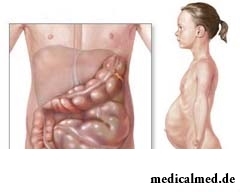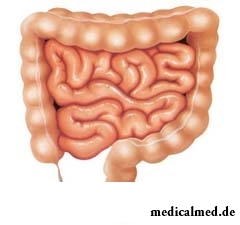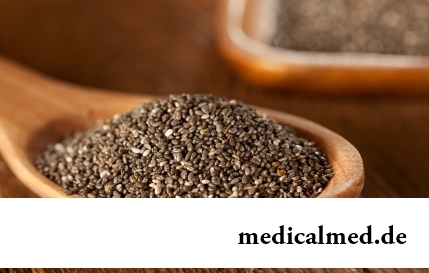





Intestinal impassability
Intestinal impassability consists in partial or complete cessation of advance of contents (chyme) on intestines. Intestinal impassability demands urgent medical intervention as it is a state, life-threatening.
Types and reasons of intestinal impassability
 On character of a current distinguish acute intestinal impassability and chronic, also intestinal impassability can be full or partial.
On character of a current distinguish acute intestinal impassability and chronic, also intestinal impassability can be full or partial.
By origin can be inborn or acquired. Inborn intestinal impassability is caused in children by anomalies of development of intestines or obstruction by its dense meconium – the stake which is formed during pre-natal fetation.
Depending on the reason which caused it intestinal impassability is divided into two look: dynamic and mechanical.
Dynamic intestinal impassability is caused by frustration of an innervation and blood circulation in intestines.
In turn is divided into the following forms:
- Paralytic intestinal impassability. Results from paralysis of a muscular layer of intestines because of what the peristaltics – the movements advancing a chyme on intestines stops. Is a peritonitis complication (a peritoneum inflammation). Paresis (partial paralysis) of intestines occurs at renal and bilious gripes, bad attacks of pancreatitis, injuries of a basin, a backbone and hematomas of an abdominal cavity, and also can be post-operational;
- Spastic intestinal impassability. The enterospasm as a result of poisoning with some medicines and salts of heavy metals is the reason of spastic intestinal impassability.
Mechanical intestinal impassability - the most often found type of intestinal impassability. It is divided into the following subspecies:
- Obturatsionny intestinal impassability. Arises in the presence of a new growth, partially or completely blocking a gut gleam (fecal stones, tumors, cysts, balls of helminths), gradual increase of symptoms is characteristic of it;
- Strangulyatsionny intestinal impassability. It is connected with a prelum or infringement of a mesentery of a gut (torsion of guts, nodes of guts), rapid development, 4-6 hours from the moment of the beginning to full impassability is peculiar to this look;
- Mixed, or the combined intestinal impassability. Arises at invagination when the gleam of intestines is corked with the implemented other gut, at the same time the mesentery of the implemented loop is squeezed. Invagination – the most frequent reason of intestinal impassability at children.
Intestinal impassability is also classified by level:
- Thinly intestinal impassability;
- Thickly intestinal impassability;
- High intestinal impassability;
- Low intestinal impassability.
Symptoms of intestinal impassability
At each type of intestinal impassability symptoms differ, however there are signs, the general for all cases:
- Emergence of a sharp abdominal pain;
- Emergence of vomiting;
- Termination of a passage of flatus and delay of a chair.
 These three symptoms of intestinal impassability have the features inherent to this state therefore it is worth talking about them slightly in more detail.
These three symptoms of intestinal impassability have the features inherent to this state therefore it is worth talking about them slightly in more detail.
- Pain. Has skhvatkoobrazny character, painful pains match a vermicular movement rhythm. At the initial stage in an interpainful interval of the patient can disturb in general nothing, and there can be a mild aching dull ache. During an attack pain becomes so intensive that patients rush about, trying to find situation in which it would decrease. The patient cannot neither shout at dive of pain, nor speak, and one of characteristic symptoms of intestinal impassability is the low moan ("ileusny groan"). At this time cold sweat acts, pulse becomes frequent – signs of painful shock appear.
- Vomiting. In case of thinly intestinal impassability repeated, exhausting, plentiful, not giving relief, in the beginning containing the remains of undigested food, then consisting of intestinal juice with bile impurity. In the next period, at accession of peritonitis, there is painful vomiting the congestive contents of lower departments of intestines having an appearance and a smell of fecal masses – "fecal vomit". At thickly intestinal impassability vomiting can be no more than one – two times, the fecal vomit at the same time is not observed.
- The symptom of a delay of a chair and passage of flatus also varies depending on a disease form. At low, or thickly intestinal impassability the chair and gases can be absent completely within several days before acute intestinal impassability. But at high, or thinly intestinal impassability at the initial stage there can be an independent chair, or the chair caused by an enema. In this case lack of a chair and gas generation can be already late symptoms of intestinal impassability.
Treat other symptoms of intestinal impassability: thirst, the blown-up stomach, a hyperperistalsis at the beginning of a disease, and its complete cessation in process of an aggravation of symptoms. At the beginning of a disease, because of a strong vermicular movement, loud intestinal noise are heard, then the peristaltics stops, and there comes complete silence – a symptom of "death silence".
During acute intestinal impassability allocate three stages:
- Initial, or the period of "ileusny groan", lasts from 2 to 12 hours. It is characterized by a pain syndrome, abdominal distention, a hyperperistalsis;
- Intermediate, from 12 to 36 hours. Pain stops at all, or loses the pristupoobraznost and intensity because of what this stage is called a stage of imaginary wellbeing. Dehydration and intoxication accrue. The peristaltics stops;
- Terminal, or late. Comes in 36 hours after emergence of the first signs of acute intestinal impassability. At this stage the condition of the patient is considerably made heavier, there comes insufficiency of all life-supporting systems of an organism.
Diagnosis of intestinal impassability
Diagnosis of acute intestinal impassability has to be immediate. The initial diagnosis is made on the basis of careful survey, definition of characteristic symptoms and tests, and also on the basis of X-ray inspection.
Treatment of intestinal impassability
Treatment of intestinal impassability begins with emergency measures on completion of the lost liquid and removal of painful shock. Upper parts of digestive tract exempt from the contents remains by means of the probe, lower parts – by means of siphon enemas. For the termination of a hyperperistalsis in an initial stage enter the spasmolysants weakening a muscular wall. Sometimes for treatment of intestinal impassability of a dynamic form these measures are sufficient for recovery of normal function of intestines.
If therapeutic methods of treatment of intestinal impassability in its dynamic form are inefficient, and in all cases of mechanical intestinal impassability, resort to an operative measure which consists in elimination of a cause of illness, in case of the occurred necrosis of the site of intestines – its excision and recovery of intestinal passability.
The first vibrator was invented in the 19th century. It worked at the steam engine and intended for treatment of female hysteria.

Statistically, can only one of ten of our compatriots brag of a decent condition of an oral cavity. On среднестатистич...
Section: Articles about health
There is a lot of fans of beer in our country. Statistically, on each average Russian (including women and children) in a year about 60 liters of this drink are consumed. It is not a lot of, as in the Czech Republic or Germany, but figure all the same impressive. Radova...
Section: Articles about health
A lot of things depend on a condition of a backbone in a human body, a backbone - not only a support for a body, it also a receptacle for a spinal cord, that is why malfunctions with a backbone are so dangerous. To treat rachis diseases very difficult and long, it is much simpler and more correct not to bring to a disease. Conforming to the rules provided in this article it is possible to avoid the majority of the problems connected with a backbone including those which are considered to be age, but a cat...
Section: Articles about health
The pine is one of the most widespread plants of our woods. Its needles and pitch not without reason called by "gallipot", since ancient times испол...
Section: Articles about health
Contrary to popular belief, the multiple sclerosis (MS) is not connected neither with sclerous changes of walls of vessels, nor with age forgetfulness and problems with concentration of attention. This disease has the autoimmune nature. Pathological process of a vyrazh...
Section: Articles about health
The naturopathy sometimes moves as the new direction of medicine, something like fashionable hobby, and there is nothing farther from the truth. This most ancient direction, the word "naturopathy" is translated as "treatment by the nature", and, no doubt, treatment by natural gifts was the first and only, available to the person in ancient times. Despite modern achievements of medicine, the naturopathy remains urgent and today, anyway the person - a part of the nature, and природн...
Section: Articles about health
Stroke (acute disorder of cerebral circulation) – one of the most widespread neurologic diseases. Annually in the world...
Section: Articles about health
The varicosity has familiarly many, statistically, this disease more than a half of all adult population. As a rule, the varicosis affects preferential superficial vessels, and is shown by characteristic cosmetic defects. Guo...
Section: Articles about health
EKO, or extracorporal fertilization - a method of treatment of infertility which became the reason of a set of broken-down copies in due time accused the people working on its creation neither more nor less of rivalry good luck. Already very few people deny the right of a method for existence, and to surprise nobody with "children from a test tube". And nevertheless, a certain magic in the procedure of artificial fertilization is, process of origin of new life is always a secret, and even it р now...
Section: Articles about health
Zone hypostases under eyes - very widespread problem giving to people is a lot of inconvenience. Hypodermic fabric in these parts having...
Section: Articles about health
Each of us repeatedly noticed that the people having the same passport age are sometimes not similar on one-years at all. One at the age of 40-45 years already looks almost an old man, and another and in 60 is young, vigorous and full of life. The matter is that state нашег...
Section: Articles about health
Dietary supplements (dietary supplements) for the last decades were so thoroughly included into our life that, apparently, it is already impossible to find the person who at least once did not try them. At the same time, most of our compatriots have a vague idea of what dietary supplements as they affect a human body consist of and what differ from the real medicines in. Let's try to understand these questions, and at the same time and to understand, such additives are how necessary for us....
Section: Articles about health
Coffee - the tonic loved by many for the invigorating aroma and deep taste. Having the stimulating effect, coffee raises ра...
Section: Articles about health
Life activity of one-celled fungi of the sort Candida, related to yeast is a proximate cause of development of candidiasis (milkwoman). Normal these microorganisms are a part of the microflora living in an oral cavity and intestines of most of people, and that...
Section: Articles about health
Impossibility to conceive the child – a trouble of many Russian families. During quite long time was considered that main "culprits" of troubles such are women. Modern physicians claim that the situation is different: about a half of failures in attempts of reproduction are connected with male infertility....
Section: Articles about health
The phenomenon of improvement of a condition of the patients at administration of drugs who are not containing active agents, so-called effect of placebo is known...
Section: Articles about health
Subfebrile temperature call fervescence to 38 degrees, and subfebrile condition - existence of such temperature over 3 days, and quite often it happens without the visible reasons. Existence of subfebrile condition - a strong indication of disturbances in an organism which can...
Section: Articles about health
It would seem, to buy drugs in Moscow does not make a problem – a drugstore, and not one, is available for each resident of the capital within walking distance. And, nevertheless, Internet drugstores become more popular – what it is possible to explain such phenomenon with? Actually there is a lot of reasons and if to formulate them it is short, then the most suitable word will be - "conveniently". We suggest to get acquainted in more detail with pluses and minuses of online drugstores that buying drugs, not to make the wrong choice....
Section: Articles about health
The sudden heat on all body which is followed by perspiration and a cardiopalmus – the phenomenon familiar to many people. Most often t...
Section: Articles about health
The medicine promptly develops, and the fact that else quite recently it seemed by miracle can now. We are not surprised any more to the fact that people with artificial joints and extremities can play sports, organ transplantation became a routine, and the latest cancer medicine п...
Section: Articles about health
All got used long ago that, having addressed the plastic surgeon, it is possible to modify natural parameters of a figure or to minimize the damages put to appearance with ruthless time. Many people (preferential women) worldwide annually decide on operations such. However there are also much more exotic interventions which are carried out seldom so far and cost expensive very much. We bring the story about the most unusual of them to your attention....
Section: Articles about health
Cellulitis - very widespread cosmetic shortcoming which arises approximately at 80% of women sooner or later. Emergence ег...
Section: Articles about health
Statistically, in Russia about 34% of citizens smoke. Most of consumers of tobacco has problems with health sooner or later. Not only smokers, but also their relatives suffer. Besides, cigarettes are expensive, and need of their acquisition heavy bry...
Section: Articles about health
Osteoporosis this general disease which main sign is decrease in density of a bone tissue. On distribution width it takes the fourth place among noninfectious diseases. The illness develops at mature age more often: in our country about a third of women and a quarter of men suffers from it 50 years are more senior....
Section: Articles about health
The chia plant, or the Spanish sage, is from South America. The indigenous people of the continent since ancient times used in food it семена:...
Section: Articles about health
All parents are ready to what the baby often and pisat much. Since then, as the absorbing diapers strongly became current, keeping of the kid in dryness does not represent any problems. But if the grown-up kid continues to urinate in panties, parents of a nacha...
Section: Articles about health
The majority of gynecologic diseases prove three main signs, each of which speaks about need of a visit to the gynecologist. Certainly, it is possible to establish the exact diagnosis only after inspection, but on the basis of some signs it is possible to assume existence of this or that pathology. Let's consider symptoms of the female diseases which are found most often....
Section: Articles about health
